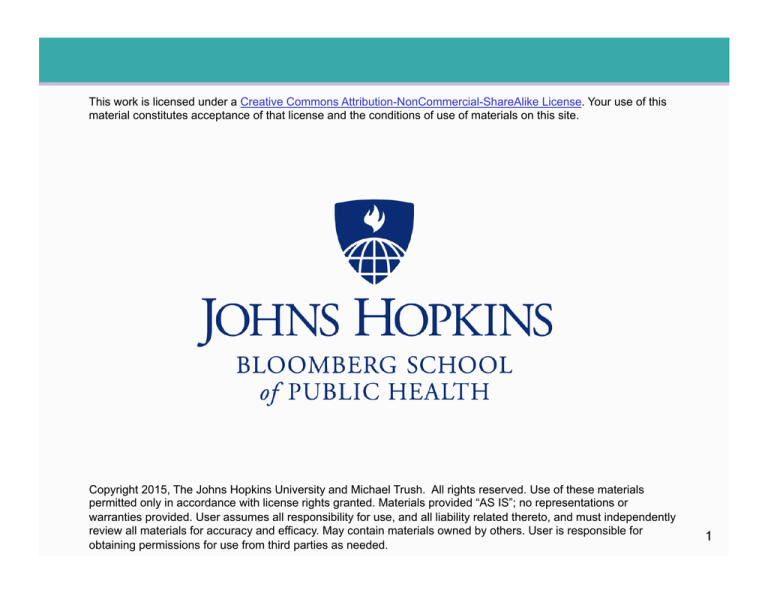
This work is licensed under a Creative Commons Attribution-NonCommercial-ShareAlike License. Your use of this
material constitutes acceptance of that license and the conditions of use of materials on this site.
Copyright 2015, The Johns Hopkins University and Michael Trush. All rights reserved. Use of these materials
permitted only in accordance with license rights granted. Materials provided “AS IS”; no representations or
warranties provided. User assumes all responsibility for use, and all liability related thereto, and must independently
review all materials for accuracy and efficacy. May contain materials owned by others. User is responsible for
obtaining permissions for use from third parties as needed.
1
Section D
Susceptibility Factors: Overview
The material in this video is subject to the copyright of the owners of the material and is being provided for educational purposes under
rules of fair use for registered students in this course only. No additional copies of the copyrighted work may be made or distributed.
Identifying Individuals at High Risk
! Can individuals at high risk/susceptibility be identified?
3
The Toxicological Paradigm
4
Susceptibility Factors
! Pharmacogenomics: branch of pharmacology which deals with the
influence of genetic variation on drug response in patients by
correlating gene expression or single-nucleotide polymorphisms
(SNPs) with a drug’s efficacy or toxicity. By doing so, pharmacogenomics aims to develop rational means to optimize drug therapy,
with respect to the patients’ genotype, to ensure maximum efficacy
with minimal adverse effects. Such approaches promise the advent
of “personalized medicine” in which drugs and drug combinations
are optimized for each individual’s unique genetic makeup.
Pharmacology: http://en.wikipedia.org/wiki/Pharmacology
Genetic: http://en.wikipedia.org/wiki/Genetics
Gene expression: http://en.wikipedia.org/wiki/Gene_expression
SNPs: http://en.wikipedia.org/wiki/Single-nucleotide_polymorphism
Efficacy: http://en.wikipedia.org/wiki/Efficacy
Toxicity: http://en.wikipedia.org/wiki/Toxicity
Genotype: http://en.wikipedia.org/wiki/Genotype
Adverse effects: http://en.wikipedia.org/wiki/Adverse_effect_(medicine)
Personalized medicine: http://en.wikipedia.org/wiki/Personalized_medicine
5
Recessive Traits That May Predispose Individuals
! Heterozygous recessive traits that may predispose individuals to
chemical toxicity
- Sickle cell trait (altered hemoglobin)
! Anemia producers: benzene, lead, cadmium
! Methemoglobin formers: aromatic amines and nitro
compounds
Blood O2 tension reducers: CO, CN
! 6
Recessive Traits That May Predispose Individuals
! Heterozygous recessive traits that may predispose individuals to
chemical toxicity
- Serum α-1 antitrypsin deficiency
Predisposition to pulmonary disease following exposure to
irritant gases
Glucose 6-phosphate dehydrogenase deficiency
! Predisposition to hemolytic anemia
! - 7
Susceptibility Factors
! Examples of the inverse correlation between allelic frequency and
cancer risk associated with inherited cancer susceptibility genes
Source: Hussain and Harris. (1998). Cancer Research, 58, 4023–4037.
8
Susceptibility Factors
! Assessing interindividual variability in:
- DNA repair: repair proficiency by plasmid-host cell reactivating
assay
- Biotransformation: phase I and phase II enzymes
9
DNA Repair Defects Increase Sensitivity to Carcinogens
! Xeroderma pigmentosum
- Failure to repair UV damage to DNA
! Ataxia telangiectasis
- Failure in repair or replication of double-strand breaks in DNA
10
Blood Lymphocyte Assay for Assessing DNA Repair Capacity
11
DNA Repair Capacity in Peripheral Blood Lymphocytes
Source: Adapted from Grossman and Wei. (1994).
12
First Basal Cell Carcinoma and DNA Repair Capacity
! Relationship between age at
first basal cell carcinoma and
DNA repair capacity
Data Source: Wei et al., (1993). Proc. Natl Acad Sci, 90, 1614–1618.
13
Taiwan
14
Black Foot Disease from Arsenic Exposure
15
Arsenical Cancer and DNA Repair Capacity
! Risk of arsenical cancer and DNA repair capacity stratified by length
of time of arsenic exposure
16
Susceptibility Factors
! Assessing interindividual variability in:
- DNA repair: repair proficiency by plasmid-host cell reactivating
assay
- Biotransformation: phase I and phase II enzymes
! ! Phenotypic: direct in vitro determination of enzyme
content and activity in biopsy specimens assay substrate/
metabolite levels and/or kinetics in blood, urine, feces,
saliva, milk, breath
Genotypic: genetic polymorphisms—deletions, SNPs
17
Procarcinogens Activated by Human CYP Enzymes
! Examples of procarcinogens activated by human cytochrome P-450
enzymes
18
Biotransformation and Cancer Risk
19
Acetylator Phenotype Distribution in Ethnic Groups
! Acetylator phenotype distribution in ethnic groups (using isoniazid)
Ethnic group
Eskimos
% rapid acetylators
95–100
Japanese
88
Black Americans
52
Caucasian Americans
48
Britons
38
Egyptians
18
20
Heterocyclic Amines
Source: Snyderwine. (2000).
! Produced by cooking meats
! Carcinogenic to breast, colon,
prostate
21
Acetylation and CYP1A2 Phenotypes
! Acetylation and CYP1A2 phenotypes in controls and cases with
colorectal cancer or polyps
22
Acetylation and CYP1A2 Phenotypes
! Acetylation and CYP1A2 phenotypes in controls and cases with
colorectal cancer or polyps
23
Preparation of Red Meat Among Colorectal Patients
! Usual preparation of red meat among 50 colorectal patients and 96
surgical controls in the Washington, D.C., area
24
Interactions between Phenotype and Dietary Exposure
Source: Adapted by CTLT from Lang et al. (1994). Cancer Epi Biomarkers and Prevention, 3, 675–682.
25
Determinants of Carcinogen-DNA Adduct Levels
26




